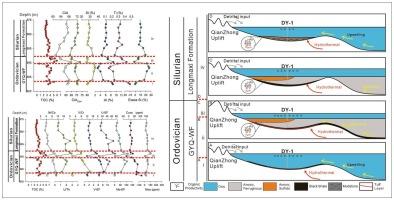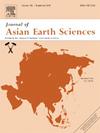Reducing environment and enhanced productivity controlled the accumulation of organic matter in the Upper Yangtze Basin, South China during the Late Ordovician-Early Silurian
IF 2.4
3区 地球科学
Q2 GEOSCIENCES, MULTIDISCIPLINARY
引用次数: 0
Abstract
The Upper Yangtze Basin developed a set of widespread organic-rich shales during the period from the Late Ordovician to the Early Silurian. The mechanisms controlling the accumulation of organic matter are the subject of much controversy. In the present study, we used various geochemical data, including total organic matter content, mineral composition, and trace and major elements from Well Daoye 1 drilled in the northern Guizhou Province, to evaluate the factors controlling the accumulation of organic matter. The indices such as CIA, Al%, Ti%, U/Th, V/Cr, Ni/Co, U-EF, V-EF, Mo-EF, Cuxs, Nixs, Excess Si, C-vaule, Cu/Al, Ni/Al, Co Mn, Zr/Cr and Zr/Al2O3 were calculated from these data to reconstruct the paleoclimate, terrigenous influx, seawater redox conditions, and paleoproductivity. Pyrite framboid size statistics were used as an additional proxy in this study to differentiate redox conditions between the anoxic state of the water column and the water/sediment interface. The results obtained from this study suggest that both the strongly reducing environment of the water column and the enhanced paleoproductivity played key roles in the widespread accumulation of organic matter. We found that the importance of these two factors in controlling the accumulation of organic matter varies under different circumstances through the Ordovician-Silurian transition in the Upper Yangtze Basin. Our study invites a case-by-case investigation when evaluating the controlling factors of organic matter accumulation in different settings.

晚奥陶世—早志留世华南上扬子盆地有机质富集受环境降低和生产力提高的控制
上扬子盆地晚奥陶世至早志留世发育一套广泛分布的富有机质页岩。控制有机质聚集的机制是许多争论的主题。利用黔北稻野1井的全有机质含量、矿物组成、微量元素和主量元素等地球化学资料,对黔北稻野1井的有机质富集控制因素进行了评价。计算了CIA、Al%、Ti%、U/Th、V/Cr、Ni/Co、U- ef、V- ef、Mo-EF、Cuxs、Nixs、Excess Si、c值、Cu/Al、Ni/Al、Co × Mn、Zr/Cr和Zr/Al2O3等指标,重建了古气候、陆源流入、海水氧化还原条件和古生产力。在本研究中,黄铁矿树状体尺寸统计数据被用作区分水柱缺氧状态和水/沉积物界面氧化还原条件的额外代理。研究结果表明,水柱的强还原环境和古生产力的增强对有机质的广泛富集起着关键作用。通过上扬子盆地奥陶—志留纪的过渡,发现这两个因素在不同条件下对有机质成藏的控制作用各不相同。我们的研究要求在评估不同环境下有机质积累的控制因素时进行个案调查。
本文章由计算机程序翻译,如有差异,请以英文原文为准。
求助全文
约1分钟内获得全文
求助全文
来源期刊

Journal of Asian Earth Sciences
地学-地球科学综合
CiteScore
5.90
自引率
10.00%
发文量
324
审稿时长
71 days
期刊介绍:
Journal of Asian Earth Sciences has an open access mirror journal Journal of Asian Earth Sciences: X, sharing the same aims and scope, editorial team, submission system and rigorous peer review.
The Journal of Asian Earth Sciences is an international interdisciplinary journal devoted to all aspects of research related to the solid Earth Sciences of Asia. The Journal publishes high quality, peer-reviewed scientific papers on the regional geology, tectonics, geochemistry and geophysics of Asia. It will be devoted primarily to research papers but short communications relating to new developments of broad interest, reviews and book reviews will also be included. Papers must have international appeal and should present work of more than local significance.
The scope includes deep processes of the Asian continent and its adjacent oceans; seismology and earthquakes; orogeny, magmatism, metamorphism and volcanism; growth, deformation and destruction of the Asian crust; crust-mantle interaction; evolution of life (early life, biostratigraphy, biogeography and mass-extinction); fluids, fluxes and reservoirs of mineral and energy resources; surface processes (weathering, erosion, transport and deposition of sediments) and resulting geomorphology; and the response of the Earth to global climate change as viewed within the Asian continent and surrounding oceans.
 求助内容:
求助内容: 应助结果提醒方式:
应助结果提醒方式:


